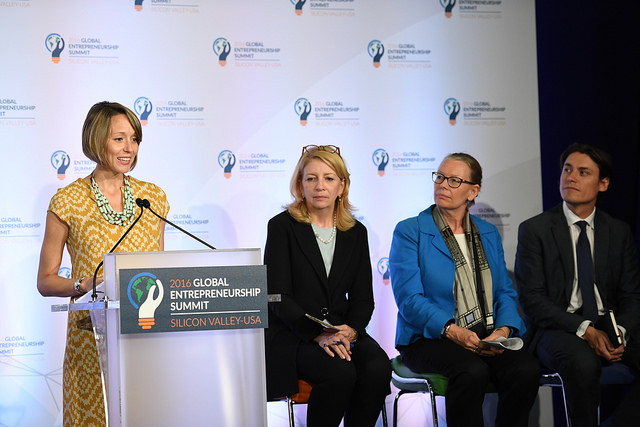Introduction
The increase of women in the workforce in the twentieth century drove U.S. GDP growth to new highs. However, as U.S. growth slowed, so did the rate of women entering the workforce. Pushing for equal representation in fields where women have been historically underrepresented may be the key to stimulating our economy.
Women’s entrepreneurship is one of these fields. Lauded by the Kauffman Foundation as an “economic tailwind that will give a boost to twenty-first-century growth” in the global economy, there is a lot of excitement surrounding the potential of women in entrepreneurship. By looking at characteristics of successful women entrepreneurs, we may gain a better understanding of how to make entrepreneurship more accessible to women.
Characteristics of Successful Women Entrepreneurs
The Kauffman Foundation and Stanford University uncovered some interesting results by surveying 350 founding CEOs, presidents, chief technology officers, and leading technologists of tech startups founded between 2002 and 2012. First, women in tech entrepreneurship are highly educated. Ninety-four percent have at least a bachelor’s degree and 56 percent have graduate degrees. Their educational training centers around business, the liberal arts, and STEM. Female entrepreneurs clearly represent a highly educated slice of the population. In comparison, only 33 percent of women in the United States possess a bachelor’s degree or higher; further, only 12 percent of women possess a graduate degree.
Performance
Research shows that female entrepreneurs experience success. On average, female entrepreneurs of all types (not just tech industries) perform seven percent better on the Kauffman Opportunity Entrepreneurship Share than male entrepreneurs. The KOES tracks the percent of new entrepreneurs who come from prior employment each year; these entrepreneurs leave their jobs to start businesses because they identified market opportunities. This indicates that women are better at identifying the market “gaps” where entrepreneurs thrive. Furthermore, women start their equally successful companies with 50 percent less capital than their male counterparts.
Nonetheless, some research finds that women entrepreneurs perform worse than men. Studies by Fundera found that women-owned businesses earn 30 percent less annual revenue than men. This could be creating a vicious circle, though; when companies make lower revenue, it is harder to access credit, making it more difficult to increase revenue in the future.
Gender Gaps
If women entrepreneurs tend to experience success, why are there so few women involved in entrepreneurship as a whole? Female-owned businesses only represent 16 percent of employing firms. Even then, these firms tend to be small, usually with employee counts in the single digits. Among high-growth, high-technology firms, women represent a mere 10 percent of founders.

Female entrepreneurs cite lack of available financial capital, lack of mentors or advisors, and the high requirements for time and effort as some of the toughest challenges in starting their businesses. Seventy-nine percent of women surveyed by the Kauffman Foundation reported using their own personal funds to start their business.
Male founders are more than three times as likely as female founders to secure financing through angel donors or VCs. Research at Babson College indicates that this difference may be linked to gender discrimination: “Because women entrepreneurs do not conform to the ‘role’ of the entrepreneur in the high growth venture, role incongruity may lead to greater perceived risk on the part of venture capital investors.”
Supporting Female Entrepreneurs
If women entrepreneurs are unable to secure funding on an equal basis with men, it may be impossible to ever see equal gender representation in entrepreneurship. We need to address gender-based biases of VC firms and other investors. Recruiting more women to the venture capital industry could help reduce unintended gender discrimination when making investments. Employee bias training programs may also help in this process.
Private and nonprofit efforts to encourage women’s leadership and entrepreneurship can be helpful as well. Initiatives like Women’s Entrepreneurship Day, the Women’s Entrepreneur Festival, and the Microsoft’s Women Think Next network are all examples of non-governmental programs that try to address women’s representation issues. Lean In Circles—small support groups made up of women in local communities and around the world— also serve as valuable tools to promote women’s economic involvement.
Government programs may also be successful in jump-starting greater women’s involvement in entrepreneurship. The City of Atlanta provided 15 women entrepreneurs the opportunity to incubate their businesses for 15 months through their the Women’s Entrepreneurship Initiative in 2016. On a federal level, implementation of more programs like the State Department’s African Women’s Entrepreneurship Program may benefit women, especially those in minority groups. One of the greatest challenges for women entrepreneurs is finding mentorship opportunities; local and state government initiatives to pair mentors with women entrepreneurs could help address this problem.
The U.S. economy is at a tipping point. In early 2016, Forbes magazine pointed out that female entrepreneurs are an “under-tapped force that can rekindle economic expansion.” However, despite strong evidence for growth potential and data supporting female entrepreneurs’ power, many barriers still exist. Through integration of more women into entrepreneurship ecosystems, we can achieve a brighter economic future for all.
Related Posts
To learn more about treatment of women within top tech companies, see the McNair Center’s blog post here.
To learn more about women in STEM fields, see the McNair Center’s blog post here.

